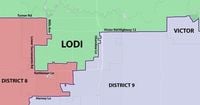California’s political landscape is bracing for a seismic shift as Democratic lawmakers, fresh from their summer recess, have moved swiftly to advance Governor Gavin Newsom’s controversial push to redraw the state’s congressional boundaries. The move, unveiled in Sacramento on August 18, 2025, is a direct response to Republican-led redistricting efforts in states like Texas, and it has ignited a fierce debate over the future of fair elections in the Golden State.
At the heart of the controversy are newly proposed congressional maps that, if adopted, would dramatically alter the makeup of California’s 52 House districts. According to The Orange County Register, the maps were presented to state legislators by the campaign arm for House Democrats late Friday, August 15, and would shrink the number of GOP-majority districts from nine to just four—a move Democratic strategists say is necessary to counteract what they see as partisan gerrymandering elsewhere.
“We’re not here because we dislike independent redistricting,” Rep. Zoe Lofgren (D-San Jose) declared at a packed news conference. “We’re here because Donald Trump and his Republican supporters are trying to rig the next election.” The sentiment echoed through the Democratic caucus, as dozens of lawmakers rallied behind a legislative package designed to fast-track the new maps and put the issue before voters in a special election this November.
The proposed legislation is sweeping. ACA 8 would amend the state constitution to allow the new congressional boundaries to take effect for the 2026, 2028, and 2030 elections—triggered only if Texas or another Republican-led state enacts similar partisan redistricting. AB 604 lays out the details of the new maps themselves, while SB 280 provides funding and guidelines for the November 4 special election, as detailed by Southern California News Group.
Governor Newsom, who has been a vocal critic of the Trump administration’s policies, applauded the package. In a statement released Friday, he said, “California and Californians have been uniquely targeted by the Trump Administration, and we are not going to sit idle while they command Texas and other states to rig the next election to keep power—pursuing more extreme and unpopular policies. This proposal would give Californians a choice to fight back—and bring much needed accountability and oversight to the Trump Administration.”
Yet, the reaction from across the aisle has been swift and fierce. Republican lawmakers, led by Assemblymember James Gallagher (R-Yuba City), staged their own news conference, denouncing the plan as a blatant power grab. “We should not abandon the principle of free and independent redistricting here in California, just for political expediency,” Gallagher stated. He warned that the Democratic plan amounted to “Gavinmandering,” a tongue-in-cheek jab at the governor, and called on colleagues to “stand up and stop it this week.”
The new maps have the potential to reshape California’s political geography in profound ways. Orange County, for example, would see its representation splintered among eight congressional districts instead of the current six, with some districts now stretching into Los Angeles County. The 42nd Congressional District, currently represented by Democrat Robert Garcia, could shift to include coastal cities like Huntington Beach and Newport Beach—areas with a more conservative bent—along with Costa Mesa and part of southern Santa Ana.
Michael Trujillo, a Democratic strategist with redistricting experience, noted, “That’s shaken up the entire map. Whether you’re in a safe seat, swing seat, whatever—things have wiggled in a way that might be uncomfortable for some communities.” He added that the changes were designed to “neutralize Texas,” meaning even safe Democratic seats would now absorb more Republican precincts.
Republican strategists see opportunities as well as challenges. Andrew Clark, who has worked on congressional campaigns in Orange County, observed, “Republicans here campaign on keeping failed L.A.-style policies out of Orange County. These new maps pack red parts of Orange County directly into deep blue parts of L.A. County.” He suggested the optics of “liberal L.A.-style Democrats like Robert Garcia parachuting down into Orange County” could provide a unique messaging angle for the GOP.
Some districts could even pit incumbent Republicans against one another. The newly drawn 40th Congressional District, which would be one of only four with a Republican majority, merges areas currently represented by Reps. Young Kim (R-Anaheim Hills) and Ken Calvert (R-Corona). Both have announced re-election bids and have sharply criticized the new maps, raising the specter of a GOP-on-GOP showdown. “Rep. Kim plans to run for re-election and is focused on delivering results for her community as she stands up against Sacramento’s unconstitutional power grab,” said Callie Strock, Kim’s campaign spokesperson.
The ripple effects extend beyond partisan lines. The changes would strengthen Democratic numbers in battleground districts like the 45th and 47th, both of which flipped or nearly flipped in recent years. In the 45th, for example, the new boundaries would boost Democratic registration to 39%, compared to 30% for Republicans, according to data shared with Southern California News Group. The 47th would also see Democrats outnumber Republicans, 36% to 32%.
However, the redistricting plan has drawn criticism from some community leaders and local officials. Carlos Perea, a Santa Ana resident and executive director of the Harbor Institute for Immigrant and Economic Justice, expressed mixed feelings. “I hate to say it, we need to fight fire with fire,” he said of California’s response to Republican efforts elsewhere. “But there’s also the contradiction of politicians essentially choosing their voters.” He warned that splitting cities like Santa Ana and Fullerton among multiple districts could dilute their political influence. “Redrawing the boundaries essentially dilutes in many ways, the impact we have as a larger city in one congressional seat.”
Former Newport Beach Mayor Will O’Neill, now chair of the Orange County Republican Party, was more blunt: “Orange County’s cities are sliced and diced in ways that only a power-hungry partisan could love.”
Despite the heated rhetoric, the fate of the new maps is far from settled. The Democratic majority in Sacramento is expected to approve the proposals by the Secretary of State’s August 22 deadline, but the final decision rests with California voters in the November 4 special election. Republican strategist Mike Madrid cautioned that convincing voters to back what many see as a partisan maneuver could be an uphill battle: “The Democrats’ response is rather than go and fight for working-class voters and fight for people of color again is to rig the system more than Republicans. In what world does that make sense?”
As the campaigns for and against the ballot measure mobilize, one thing is certain: California’s redistricting battle is poised to become a defining issue in the 2026 midterms, setting the stage for a high-stakes fight over the future of representation in America’s most populous state.





